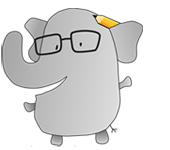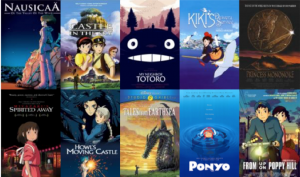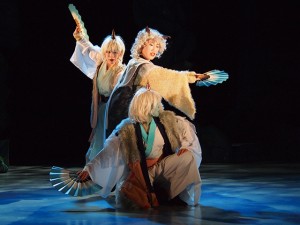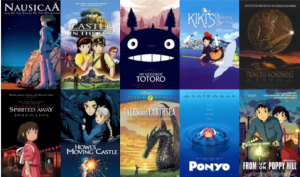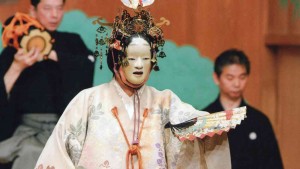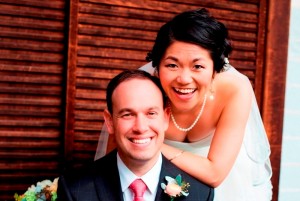JQ Magazine: Nippon in New York — Studio Ghibli, Asa Akira, Liberty City Anime Con, Sekai no Owari
By JQ magazine editor Justin Tedaldi (CIR Kobe-shi, 2001-02). Justin has written about Japanese arts and entertainment for JETAA since 2005. For more of his articles, click here.
In the dog days of summer, it’s best to escape the heat in a place that’s cozy and cool. For those into Japanese cultural events, this month offers a diverse selection of film premieres and live music—all in the comfort of indoor air conditioning.
This month’s highlights include:
Various dates from Aug. 3
Village East Cinema, 181-189 Second Avenue
$10, $15
This month, Village East Cinema presents four more films from the legendary Studio Ghibli and Academy Award-winning director Hayao Miyazaki! Here’s your chance to enjoy some Japan’s greatest and most influential animated films on the big screen. The morning screenings are English dubbed versions, while the evening screenings are in Japanese with English subtitles. This month’s selections include Japan’s all-time box office champ Spirited Away (Aug. 3-4), Howl’s Moving Castle (Aug. 10-11), Tales from Earthsea (Aug. 17-18), and From Up on Poppy Hill (Aug. 31-Sept. 1).
Tuesday, Aug. 9, 2016
Asa Akira, Dirty Thirty
$12.99 Kindle, $13.64 paperback
The world knows her as a porn star…but it’s her way with words that will touch you again and again. As she contemplates turning thirty years old while still being in the adult film trade, Asa Akira delves into her past, present, and future, exploring the events that brought her to where she is now and the surprising and insightful plans she has for her future. Asa’s perceptive, funny, and straightforward writings on love, sex, death, marriage and celebrity come together in this surprising book of essays that will have you laughing hysterically one minute and deep in reverent thought the next. Personally revealing as well as universal, Dirty Thirty marks the coming of age of a new literary star.
Aug. 12-17
Flamboyán Theater at The Clemente, 107 Suffolk Street
$13-$18
OZmate, a musical theater company based in Takarazuka, proudly presents The Legend of Oni with an all-female cast as part of the New York International Fringe Festival (FringeNYC)! The Legend of Oni is a musical about two Oni, ogres in Japan, in the pre-samurai Heian period. Lose yourself in the beautiful Japanese days of old with wonderful kimono costumes under the direction of Naoko Tsujii. OZmate also appears earlier this month as part of J-Summit New York at the Bowery Electric (327 Bowery) on Sunday, Aug. 7, with additional performances by Truthseekers, LUST, Lulla LayLa, Tamuro Rie, Naoki, Megumi, Shino Frances, Takaro Nishimura, and Emi Matsushita. Doors open at 5:30 p.m.; tickets are $15 advance, $18 at the door (includes one drink).
JQ Magazine: Nippon in New York — Studio Ghibli, JAPAN CUTS, Hotei, ‘Takarazuka CHICAGO,’ Kyary Pamyu Pamyu
By JQ magazine editor Justin Tedaldi (CIR Kobe-shi, 2001-02). Visit his Examiner.com Japanese culture page here for related stories.
After you’ve seen the outdoor fireworks, enjoy some summer events in the cool indoors, whether it’s catching one of the dozens films premiering at Japan Society’s annual festival, or enjoying anything from traditional theater to the latest pop sensation.
This month’s highlights include:
Various dates beginning July 6
Village East Cinema, 181-189 Second Avenue
$10, $15
This month, Village East Cinema presents four films from the legendary Studio Ghibli and Academy Award-winning director Hayao Miyazaki! Every Wednesday and Thursday from July 6 through July 28 offers a chance to enjoy some Japan’s greatest and most influential animated films on the big screen. The morning screenings are English dubbed versions, while the evening screenings are in Japanese with English subtitles. July’s selections include Castle in the Sky, My Neighbor Totoro, Kiki’s Delivery Service, and Princess Mononoke.
July 13-17
Rose Theater, Broadway at West 60th Street, 5F
$30-$125
In the enigmatic Japanese dramas of Noh, ancient stories from classical Japanese literature and oral traditions come to life in a sublime, ritualized blend of poetry, music, drama, and dance. The divide between the natural and supernatural is bridged as spirits and humans interact in a world rife with symbolism. The nearly 700-year-old dramatic form—known to many for its highly stylized masks and elegantly simple set featuring a single pine tree—is one of the world’s oldest continuously performed genres of performance art and was recently designated an “Intangible Cultural Heritage” by UNESCO. Kiyokazu Kanze—the 26th Grand Master of the Kanze School and a descendent of the founder of Noh—brings the profound lyricism and aesthetic elegance of this ancient dramatic art form to New York as part of this year’s Lincoln Center Festival. A special lecture and demonstration by Kiyokazu Kanze will be held July 12 at Japan Society; click here for more info and tickets.
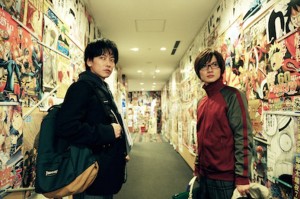
‘Bakuman’ © 2015 TOHO Amuse DENTSU SHUEISHA Victor KDDI GYAO Crescendo NIPPAN JR Kikaku LINE © Tsugumi Oba, Takeshi Obata SHUEISHA All Rights Reserved.
July 14-24
Japan Society, 333 East 47th Street
$10-$20 (single screenings)
North America’s largest festival of new Japanese film returns for its 10th anniversary edition, offering eleven days of impossible-to-see-anywhere-else screenings of the best new movies made in and around Japan with special guest filmmakers and stars, post-screening Q&As, parties, giveaways and much more. With special guests such as Lily Franky, Atsuko Maeda and Sion Sono, this year’s festival guest list is the largest in history, and includes directors, stars, producers and more. Make sure to also check out this year’s expanded DOCUMENTARY FOCUS and EXPERIMENTAL SPOTLIGHT sections. Venture out of the mainstream to discover new work by some of Japan’s most vital and interesting nonfiction and avant-garde practitioners. The experimental lineup is dedicated to animation, offering vibrant short-form alternatives to the ubiquitous anime for which Japan is so famous.
JQ Magazine: Manga Review — ‘The Birth of Kitaro’

“If you enjoy jaunts into the fun and mysterious realm of comics and mythology, don’t hesitate to pick up this affordable volume that offers a perfect introduction to a series that has captivated the imagination of generations.” (Drawn and Quarterly)
By Julio Perez Jr. (Kyoto-shi, 2011-13) for JQ magazine. A bibliophile, writer, translator, and graduate from Columbia University, Julio currently keeps the lights on by working at JTB USA while writing freelance in New York. Follow his enthusiasm for Japan, literature, and comic books on his blog and Twitter @brittlejules.
What has hair as sharp as needles, a tongue like a chameleon’s, and one empty eye socket to keep its father in? If you could only guess some kind of crazy monster…well, then you’re not far off!
Shigeru Mizuki’s Kitaro: The Birth of Kitaro is a manga volume collecting seven classic paranormal stories of the titular character from the 1960s. They include Kitaro’s origin, and yokai files with more information about his fascinating friends and enemies that endure in myth and pop culture. All are translated and written by none other than our very own Shigeru Mizuki expert (and JQ interviewee), Zack Davisson (Nara-ken, 2001-04; Osaka-shi, 2004-06).
But who is Kitaro? And what are yokai?
Kitaro is one of many yokai (basically a mysterious Japanese monster/spirit/phenomenon) that have been making waves across the world through movies, anime, video games and, of course, manga. Born from two other human-like yokai who were unable to raise him due to sickness, Kitaro was entrusted to the care of humans at a young age. Even while growing up, he could not disguise his heritage or hide from the adventures it would bring him.
Despite his child-like stature, Kitaro is a giant in the genre of yokai stories in Japan thanks to the brilliance of his creator, the legendary late artist Shigeru Mizuki. Since earlier this decade, Drawn and Quarterly has been a major force in publishing Mizuki’s works into English (nine books to date) and contributing to the boom in America of Mizuki’s work and yokai. You may already be familiar with his eerie adventures in Drawn and Quarterly’s first collection of Kitaro stories released in 2013 and translated by Jocelyn Allen. Beginning with this volume, and continuing in several more to come, more of Kitaro’s hijinks can be enjoyed in a format and price point friendly to all ages.
JQ Magazine: Book Review — ‘Monkey Business Volume 6’

“In addition to the stories profiled here, there are other works that will make you laugh while taking you to a Japan that might not have even existed in your imagination.” (A Public Space)
By Rashaad Jorden (Yamagata-ken, 2008-10) for JQ magazine. A former head of the JETAA Philadelphia Sub-Chapter, Rashaad is a graduate of Leeds Beckett University with a master’s degree in responsible tourism management. For more on his life abroad and enthusiasm for taiko drumming, visit his blog at www.gettingpounded.wordpress.com.
Upon picking up the sixth volume of Monkey Business: New Writing from Japan, the first thought that popped into my head was that I would be introduced to epic Japanese works and/or more prominent authors from the country. After all, several award-winning writers—including Mieko Kawakami, Satoshi Kitamura and Hiroko Oyamada—produce works that appear in this volume. Quite possibly, some of the stories in this 21-piece set might become classics in Japanese literature. Or at the very least, this newbie to the Monkey Business series might discover new aspects of Japan—or be reintroduced to certain things—in rather unforgettable tales.
And well…this edition of Monkey Business doesn’t lack colorful stories. Several of them stand out, including the first one – “Forbidden Diary.” No, it doesn’t serve as an educational tour of Japanese history or culture. Instead, this excerpt of Sachiko Kishimoto’s fictional diary introduces us to a “Phantom Old Man” who has experienced Japan a little differently from the way you might have.
Let’s see…the old man (who is actually being taken care of by the narrator) remembers Shibuya as being totally void of people, as only a haven for rice paddies and without its iconic scramble crossroads. In addition to seemingly arriving out of the Stone Age, the old man repeatedly changes appearances during the story.
JQ Magazine: JQ&A with Patrick Bartley of J-MUSIC Ensemble
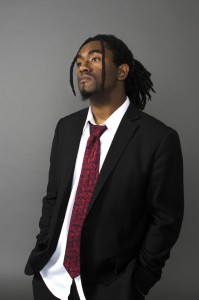
“When it comes to art, there’s always a certain level of intensity that I like, because I like seriousness—especially when it comes to an almost religious seriousness in doing music or art for a higher presence. I love that about Japanese aesthetics.” (Armando Zamora)
By Rashaad Jorden (Yamagata-ken, 2008-10) for JQ magazine. A former head of the JETAA Philadelphia Sub-Chapter, Rashaad is a graduate of Leeds Beckett University with a master’s degree in responsible tourism management. For more on his life abroad and enthusiasm for taiko drumming, visit his blog at www.gettingpounded.wordpress.com.
People from all over the world come to New York to launch their careers in entertainment. But can you do so in the world of Japanese music?
Patrick Bartley has. A Florida native who was inspired at a young age by the sounds of classic video game scores like Sonic the Hedgehog and Streets of Rage, Bartley came to New York to study at the Manhattan School of Music and later formed the J-MUSIC Ensemble, an multi-instrumental group that mixes the various genres that make up the Japanese music scene. A Grammy-nominated saxophonist and composer with a jazz background, Bartley formed the group as a way to express his admiration for the music he first discovered through video games, anime themes and J-pop classics.
The J-MUSIC Ensemble is currently recording their debut album, and their numerous live performances over the past year have led to this week’s release of the band’s first-ever single, FUTUREBOUND, available May 6. The group is celebrating with a special launch party performance that night at Shrine World Music Venue in Manhattan, followed by a performance at ShapeShifer Lab in Brooklyn May 8 with Tokyo electronic music pioneer Coppé and recording artist Kaoru Watanabe.
Keeping busy as a fulltime musician, Bartley has performed with artists as diverse as Wynton Marsalis, Steve Miller and Igor Butman, and earlier this year he bantered on-camera with Stephen Colbert for a taping of The Late Show as a guest with house band Jon Batiste and Stay Human. En route to another gig earlier this year, JQ caught up with him over falafel in Harlem for this exclusive interview.
What should readers know about the J-MUSIC Ensemble?
Even though we feature singers, when you go to a J-MUSIC Ensemble concert, you’re going to experience the music you’re used to hearing in a totally different way, because we put the horns in the front line in the same positions as singers. We want you to feel the horns just as powerfully as you would hear the other elements like the dancing and the singing. But this time, you’re putting the music under a microscope and really giving you the full experience. We’re also taking these songs and putting improvisational elements into it—we’re taking a microscope and putting jazz elements into it. But at the same time, we’re keeping the core essence of the music. We’re not just playing jazz songs; we’re taking the jazz mentality. We’re still playing rock. We’re still playing funk. We’re still playing pop. We still feel that exact feeling, but with a human element—live instruments and live bands performing it. There’s really nothing like it.
What projects are you and the J-MUSIC Ensemble working on at the moment?
The most recent thing we’re excited about is our single release on May 6. With this, people can finally get real, downloadable audio files to keep with them no matter what, and in high quality! We spent a great deal of time and invested a lot to get this working, and the mixes and masters turned out great. Other than this, the band itself is really the project. The way I think of this, project-wise, is I’m constantly looking at this huge, vast sea of Japanese music, art, and cultural history—and I often find myself asking the question, “Where do I start?” So, in that regard, I usually pick what I think can work best for the band, so that we can spend time developing our sound and finding what our natural tendencies are, you know? As well as just what the optimal horn sounds are, and if stuff is electronic, I have to figure out what’s possible to play live with real instruments. Right now, we’ve found that [J-pop band] Perfume is perfect for our instrumentation, so we’re going to keep exploring that, mainly, until we continue to find our sound.
How has Japan influenced your music?
The way Japan has influenced my music has been through understanding the history of the country. And even though I really haven’t gone there, I observe as much as I can, such as the intensity by which they operate on a day-to-day basis in everything. When it comes to art, there’s always a certain level of intensity that I like, because I like seriousness—especially when it comes to an almost religious seriousness in doing music or art for a higher presence. Like actually taking it seriously and creating something that no matter what creates deep emotions and passions.
I love that about Japanese aesthetics. That always has touched me and I think I’ll never really forget it. And then there’s the language, too. It’s a totally different way of thinking, so it’s influenced the way I think about rhythm.
JQ Magazine: Book Review — ‘You Are My Best Friend’
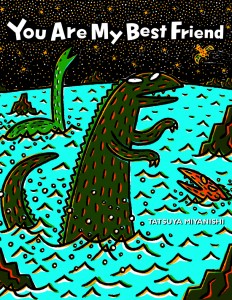
“Parents will enjoy the dinosaur’s uncanny resemblance to Godzilla and may even learn a thing or two about prehistoric creatures. Don’t worry, your kids won’t have a clue if you don’t pronounce them correctly—they’ll be too enthralled with the captivating story and dramatic images.” (Museyon)
By Heather Wilson Tomoyasu (Ibaraki-ken, 2004-06) for JQ magazine. Heather is a vlogger and blogger on her site US Japan Fam, author of “Legit Ways to Make Money from Home” (available on Kindle and iTunes), social media consultant, and mommy to twins plus one! You can follow and connect with her on Twitter, Instagram, Facebook, and Pinterest.
After a popular debut in his first children’s book, You Look Yummy, our tough but lovable friend Tyrannosaurus is back and better than ever thanks to author Tatsuya Miyanishi and his English publisher, Museyon (who also brought you 2014’s Kuma-Kuma Chan, the Little Bear). The second of a 13-book series, You Are My Best Friend features a similar transformation of the dinosaur from a violent and selfish creature to a kind and caring one, this time through the act of making a friend.
Through 26 vivid and brightly colored illustrations over 40 pages, you’ll follow Tyrannosaurus as he taunts smaller dinosaurs, finds himself ironically near death, and is then saved by another dino. This act of unexpected kindness brings about a change of heart in our tyrant, who suddenly finds himself with a best friend whom he must (spoiler alert!) in turn save at the end. The book is a heart-warming moral story that also serves up exciting twists and turns.
Parents will enjoy the dinosaur’s uncanny resemblance to Godzilla and may even learn a thing or two about prehistoric creatures. Elasmosaurus, anyone? How about Styracosaurus? No? Me, neither. Don’t worry, your kids won’t have a clue if you don’t pronounce them correctly—they’ll be too enthralled with the captivating story and dramatic images.
JQ Magazine: Book Review — ‘Japaneseness: A Guide to Values and Virtues’
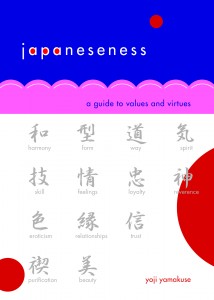
“Japaneseness serves as the perfect introduction (or reintroduction) to many aspects of Japanese society you might find refreshing, fascinating or befuddling. Or at the very least, quintessentially Japanese. ” (Stone Bridge Press)
By Rashaad Jorden (Yamagata-ken, 2008-10) for JQ magazine. A former head of the JETAA Philadelphia Sub-Chapter, Rashaad is a graduate of Leeds Beckett University with a master’s degree in responsible tourism management. For more on his life abroad and enthusiasm for taiko drumming, visit his blog at www.gettingpounded.wordpress.com.
During my time in Yamagata Prefecture, I remember learning about filial piety, a virtue that the Japanese have historically cherished. I had heard about countless other values, principles and virtues that have been important in the daily lives of Japanese people. But I had totally forgotten them until…
Picking up a copy of Japaneseness: A Guide to Values and Virtues. Written by Yoji Yamakuse, Japaneseness serves as the perfect introduction (or reintroduction) to many aspects of Japanese society you might find refreshing, fascinating or befuddling. Or at the very least, quintessentially Japanese.
Yamakuse appropriately starts off the book by introducing readers to the value Japanese tend to treasure the most: harmony. Certainly, those familiar with the country recognize the importance of harmony in ensuring that a Japanese environment operates smoothly, and Yamakuse spends the first chapter explaining how related concepts (such as hospitality, thoughtfulness and modesty) contribute to maintaining harmony. That chapter—as well as the following eight (some of which are devoted to values like trust, virtue and reverence for the gods)—are further divided into sections that address other values and beliefs that are important in Japan.
JQ Magazine: 3/11 — Where We Stand Five Years Later
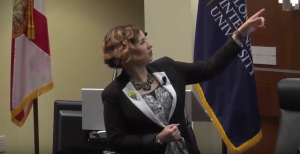
Bahia discusses the earthquake that struck Japan on March 11, 2011 at Florida International University, March 8, 2016. (Courtesy of Bahia Simons-Lane)
By Bahia Simons-Lane (Gunma-ken, 2005-07) for JQ magazine. Bahia taught at an all-girls’ high school on JET, and following her time on the program she held the position of ALT Advisor for the Gunma Board of Education from 2007-08. Bahia earned her master’s degree in International and Intercultural Education and certificate in Asian Studies from Florida International University in 2014, and is currently pursuing her Ph.D. in Curriculum and Instruction, Language, Literacy, and Culture. She is president of the Florida chapter of the JET Alumni Association.
On March 11, 2011, I woke up like it was any other day, but minutes after I walked downstairs I realized it wasn’t. Two of my friends were staying with me at the time. When we came downstairs the first thing they said to us was, “Did you hear about what happened in Japan?” We spent the rest of the day glued to the Internet and TV, horrified and shaken by the devastation caused by the earthquake and tsunami. That was five years ago.
This March 11 marked the five-year anniversary of the triple disaster that devastated the Tohoku region of Japan. The earthquake and subsequent tsunami killed thousands of people with many more displaced from their homes. Yet, like with many disasters over time, people stop thinking about what happened and it fades into the background. With the five-year anniversary approaching, I realized that I hadn’t heard a lot about how the Tohoku recovery was progressing. I knew that those without strong ties to Japan had probably forgotten all about the disaster entirely. It was time to look into how the recovery had progressed and share it with students at Florida International University who may not know much about the disaster, so I pitched the idea to the organizer of the Tuesdays Times Roundtables (TTRs) and it was agreed that it would be a great addition to the spring lineup.
FIU’s Office of Global Learning presents TTRs every week in conjunction with the New York Times. I proposed the talk for the March 8 roundtable, which seemed like perfect timing to discuss the 3/11 earthquake. The TTRs are a series of talks that focus on news items published in the New York Times and offers a closer look at some of the articles and the issues they address. The TTRs are usually well attended, and my talk was no exception, with approximately 40 people in attendance. Mostly students, they were avid listeners who asked interesting questions and made insightful comments (view the video of the complete presentation for more).
JQ Magazine: ‘Jewels of Kyoto’ Brings Geisha Tradition to Australia
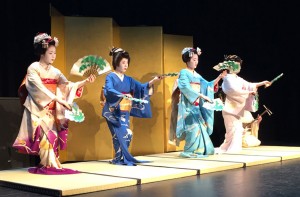
Jewels of Kyoto performed Matsu Zukushi in Sydney Feb. 23. This dance is characterized by the use of fans with a pine branch design, which represents the courage, determination and fidelity of a woman. (Eden Law)
By Eden Law (Fukushima-ken, 2010-11) for JQ magazine. Eden currently serves Country Representative for Australia and President of JETAA New South Wales.
Jewels of Kyoto was a tour of Australia and New Zealand by a group of geiko and maiko from Kyoto’s Gion district, sponsored by Japan Foundation, which ran from February 23 to March 5. Commenting for this article were Ms. Ayusa Koshi from Japan Foundation and two members of the tour group: Mr. Katsuroku-shisho of Ochaya Tomikiku, who instructs its maiko and geiko in traditional music, and Ms. Tomitae, a maiko also of Ochaya Tomikiku.
The geisha is one of the most recognisable cultural images of Japan, a symbol of the grace and beauty in Japanese traditional culture that is popular domestically and internationally. But seeing a real geisha (defined as someone who has undergone the requisite training in song, dance and social arts) is rare, and these days found only in very few places in Japan. Kyoto, of course, is best known as the place to spot geisha (or geiko, as they are known locally), and maiko (apprentice geiko) hurrying down the narrow cobbled streets of kagai (or geiko districts) in full traditional gear. As explained by Koshi, manager of Japan Foundation’s Arts and Culture Department: “Watching a geisha perform isn’t as simple as purchasing a ticket to a kabuki show. Traditionally, their artistic services were exclusive to the wealthy [who possess] the right connections, and this custom lingered until recent years.”
This is why the debut of the Jewels of Kyoto tour in Sydney was met with enthusiasm, selling out the nearly 400-seat capacity Lendlease Darling Quarter Theatre in Darling Harbour. Featuring a performance of traditional song, dance and party games (geiko are entertainers, after all) by a group of geiko and maiko, it was made possible by a collaboration between Japan Foundation and Ms. Reiko Tomimori, a prominent figure in Kyoto’s geiko world. Apart from the main stars (the geiko Hinagiku and Ryoka, and the maiko Tomitae and Tomitsuyu), there are other musicians and accompanying props and costumes.
JQ Magazine: JQ&A with Julia Inisan, CLAIR Programme Coordinator
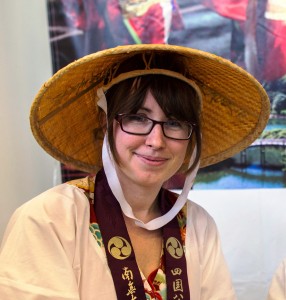
“JET Programme participants are in a very good position to match supply with demand by bringing people together, and there are many great examples of ALTs, CIRs and SEAs using crowdsourcing, social networks, recorded videos, and event planning to support their local community.” (Courtesy of Julia Inisan)
By Rashaad Jorden (Yamagata-ken, 2008-10) for JQ magazine. A former head of the JETAA Philadelphia Sub-Chapter, Rashaad is a graduate of Leeds Beckett University with a master’s degree in responsible tourism management. For more on his life abroad and enthusiasm for taiko drumming, visit his blog at www.gettingpounded.wordpress.com.
Julia Inisan (Kagawa-ken, 2013-15) first visited Takamatsu City, the capital of Kagawa Prefecture in Shikoku, in 2011 on a two-week tea ceremony study tour. That excursion served as a life-changing experience for the Frenchwoman as she fell in love with the city and decided to apply for a spot as a CIR there.
As a JET, Inisan has established herself as a valuable member of her local community, working diligently to attract tourism to the area and promote it on a global stage. But Inisan’s work in Japan has been far from limited to just Shikoku: She currently works to support the next generation of JETs as a programme coordinator for CLAIR. JQ caught up with her to discuss her history and blossoming career in Japan.
What attracted you to Japan in the first place?
As an elementary school student, I was fascinated by mythology and folklore and started reading classics like the Kojiki (Records of Ancient Matters) translated into French. I was also moved by the aesthetics expressed in works such as Murasaki Shikibu’s novel The Tale of Genji and Hayao Miyazaki’s movie Princess Mononoke, and I decided to study Japanese in high school to learn more about the archipelago’s traditional culture.
I then had the opportunity to study for one year at Higashi High School in Kitakata, where I fell in love with Fukushima Prefecture’s gorgeous landscapes, and later at Kyoto University, another life-changing experience. What kept me coming back each time was the kindness of the locals, which helped me feel at home despite the cultural differences.
What made you decide to become a CIR, and what was that like compared with your previous experience living in Japan?
I was a CIR in Takamatsu City from 2013 to 2015. I had always wanted to work for the Japanese local government and promote lesser-known areas of Japan, which is why I applied for the job. As I already had strong connections to Takamatsu, receiving my acceptance letter was one of the happiest moments of my life.
I was Takamatsu City Office’s first CIR. Without a predecessor, it was difficult for me to grasp the extent of my responsibilities at first. Fortunately, I received great advice from the CIRs working at Kagawa Prefecture and from my JET Programme sempai. Finding a good balance between work, volunteering, and private time was also challenging, but my experiences with the local community have been incredibly rewarding.
You currently work as a programme coordinator for CLAIR in Tokyo. How did that opportunity come about, and what kinds of things are you responsible for?
When my two-year contract ended in Takamatsu, my contracting organization encouraged me to apply to be a programme coordinator job at CLAIR. I felt very grateful to the JET Programme and wanted to contribute to its development while supporting Japan’s local communities at a global level. I am learning a lot from my Japanese and foreign coworkers at CLAIR, and most of all from the feedback we receive from JET participants.
I currently work on a wide variety of projects, such as planning content for Post-Arrival Orientations and the CIR Mid-Year Conference, revising publications like the CIR Handbook, and directing workshops at ALT Skill Development Conferences. Last year, I was fortunate to work in cooperation with Kagawa Prefecture to welcome back Sophie Le Berre (CIR Kagawa-ken, 1995-97), one of the 12 JET Programme alumni who returned to their former places of work as part of CLAIR’s Satogaeri Project.
I am also part of the team in charge of the JET Programme Video Contest, which started in October last year. We have received lots of awesome submissions from current and former JET participants promoting their regions from their points of view. I am greatly impressed by the quality and creativity of the videos, which you can view and vote for on the contest’s website. I hope more and more JET participants will participate in this initiative, as these videos are helping tourists discover amazing areas of Japan they’ve never heard of. If you are interested in the contest and missed the deadline for the Autumn/Winter edition, don’t worry: from April 7, 2016, you can still participate in the Spring/Summer edition.
JQ Magazine: Carnegie Hall Hosts ‘Grand Japan Theater’
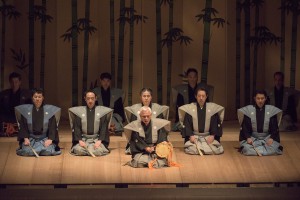
The noh portion of the evening featured Living National Treasure Kamei Tadao: “For those who attended, this was a once-in-a-lifetime experience, which fulfilled the promise of Japanese performing arts that made many of us fall in love with the culture in the first place.” (Masahito Ono)
By Vlad Baranenko (Saitama-ken, 2000-02) for JQ magazine. Vlad is an avid photographer.
On March 1, Carnegie Hall’s Stern Auditorium hosted Grand Japan Theater (also billed as An Evening of Japanese Traditional Theatre), which presented New York City with a spectacular rare performance of kyogen, noh and kabuki—all in one night. After kicking off their international tour in Tokyo and Osaka, then traveling halfway across the globe to introduce the first ever kabuki/noh performance to the royal family of Fujairah in the United Arab Emirates, the troupe finally arrived in the U.S. for one special night.
A sold-out crowd of over 2,800 witnessed some of the biggest names in traditional Japanese theater, including the noh otsuzumi artist Kamei Tadao, who in 2002 was designated as a Living National Treasure; the internationally renowned kabuki and television actor Ichikawa Ebizo XI, who began his career at just six years old and has evolved into one of the most versatile traditional actors today; and many more with direct roots to these beautiful centuries-old art forms.
The backdrop for all of the evening’s performances featured three sets of traditional Japanese screens adorned with illustrations of bamboo that blended perfectly into the background despite the enormity of the hall. The night’s program began with the kyogen piece Sanbaso. (Kyogen, an art form that almost always accompanies a noh performance and acts as a short, often comical “intermission piece” for the audience, has traditionally been based on a Shinto religious rite that prays for peace, fertility and prosperity across the land.)
JQ Magazine: Book Review — ‘The Japanese Lover’
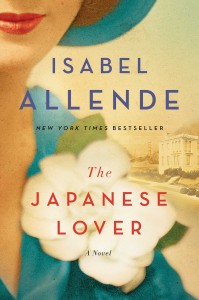
“The Japanese Lover has its ups and downs, but it does serve as an eventful tour of various aspects of 20th century history.” (Atria Books)
By Rashaad Jorden (Yamagata-ken, 2008-10) for JQ magazine. A former head of the JETAA Philadelphia Sub-Chapter, Rashaad is a graduate of Leeds Beckett University with a master’s degree in responsible tourism management. For more on his life abroad and enthusiasm for taiko drumming, visit his blog at www.gettingpounded.wordpress.com.
We might be keeping fascinating mementos from our daily lives that if discovered, might stun many people.
Certainly, letters documenting something shocking (well, shocking during a certain period of history) would classify as that. Isabel Allende’s The Japanese Lover highlights one woman’s relationship with a Japanese national during her eventful life.
The story’s protagonist is Alma Belasco, a native of Eastern Europe was sent to live with well-to-do relatives in San Francisco when she was young. During the latter years of Alma’s life, she lives with a caretaker named Irina Bazili, who learns about an important figure who shaped Alma’s life and is described in the title of the book: a man named Ichimei Fukuda. Ichimei could also be described as a secret lover because the two had to keep their romance on the down low as it occurred during the height of World War II when people of Japanese descent were considered a threat to American society. The Japanese Lover also takes a journey not only through Alma’s life, but Irina’s as well as Ichimei’s.
JQ Magazine: JETAA Sakura Sweethearts
By Rick Ambrosio (Ibaraki-ken, 2006-08) for JQ magazine. A dusty old fixture of the JET Alumni Association of New York (JETAANY) community, Rick manages projects at a software company by day and sends drafts late into the night as a writer for JQ.
Well, folks, it’s that time of year again. Maybe you have a special someone you’re going out with on Valentine’s Day. Perhaps you’re grabbing a bunch of friends and doing a “singles karaoke night” instead (Like some JETAANY folks are). Maybe you forgot and this is a great reminder to get some flowers and make a dinner reservation ASAP. Either way, you can only hope for the best.
But some people seem to luck out in love, and I have to say I’m happy when it’s people I like. And what kind of people do I often like? JETs. That’s right, folks, we are going to interview some Cupid-conquering JET couples and get to know how they met, where they came from, and maybe a little advice on how to spark a little JET romance of your own. So if you find yourself at that next JET alum enkai thinking “what if…?,” this might be for you.
Chau Wing Lam (Gunma-ken, 2005-07) and John Ciocco (Saga-ken, 2006-07)
Did you meet on while on JET? Or after JET through an alumni meeting?
We met during a JETAANY alumni event—a boat cruise on August 20, 2008.
How long have you been together?
We’ve been together since 2008, married in 2014.
Was it your mutual love for Japan that brought you together, or something else?
Mutual love for Japan gave us something to start talking about, then the rest of our conversation filled in from there. We actually got married at the Shofuso Japanese House and Garden here in Philadelphia to commemorate what brought us together.
Have you guys ever had to do the “distance” thing? If so, what was that like?
Yes. When we first met, Chau was living in Hoboken and John was living in South Jersey. The commute was about two hours each way, so we only saw each other on weekends. We had some challenges at first being that far away and with the both of us trying to cultivate a new relationship, but we worked through it. Chau moved to Philly in the fall of 2009, shortening the commute to about half an hour—and now we’re married with a four-and-a-half-month-old baby!
Has being on JET made you a “stronger” couple? If so, how?
It’s a shared history that grounds us and helps us remember the many commonalities we have despite our inherent differences. We both learned to be self-deprecating to try and get our students interested in English, and that is definitely a quality that we love about each other and helps us through arguments that arise. Relationships aren’t easy, but we work at it every day—so yes, in some ways, knowing how far out of our comfort zone we’re able to stretch helps us.
What advice do you have for other budding JET couples?
Always remember to have fun with each other as you did in Japan—ALWAYS. And use your commonalities to help bridge the gap when the divide seems too wide!
JQ Magazine: New York Pledges Allegiance to George Takei at Japan Society

George Takei (right), with moderator Kermit Roosevelt at Japan Society, New York, Jan. 2016. (Ann Chow)
By Lyle Sylvander (Yokohama-shi, 2001-02) for JQ magazine. Lyle has completed a master’s program at the School of International and Public Affairs at Columbia University and has been writing for the JET Alumni Association of New York since 2004. He is also the goalkeeper for FC Japan, a New York City-based soccer team.
On Jan. 25, George Takei participated in a talk at Japan Society in New York. Best known for playing the role of Sulu on the original Star Trek and its movie incarnations, Takei has embarked on a second career as a social rights activist. Takei’s childhood in a pair United States internment camps for people of Japanese descent during World War II provided the focus for the conversation (entitled From Barbed Wire to Broadway), which was moderated by Kermit Roosevelt, a constitutional law scholar at the University of Pennsylvania (and great-great grandson of President Theodore Roosevelt). Takei is also concurrently appearing on Broadway in a musical inspired by his internment experiences called Allegiance (book by Marc Acito, Jay Kuo and Lorenzo Thione; music and lyrics by Jay Kuo). The show, also starring Lea Salonga and Telly Leung, is playing at the Longacre Theatre through February 14.
There is no doubt that Takei’s childhood experiences formalized his worldview and search for justice. He spoke at length of his memories of being forced out of his Los Angeles home at the age of five and relocated to the Rohwer War Relocation Center for Internment in Arkansas, and later, the Tule Lake War Relocation Center in central California. Takei also put his personal experiences within a historical and political context: After the bombing of Pearl Harbor, anti-Japanese paranoia made all U.S. citizens of Japanese heritage suspect. Due process of law was completely suspended as Japanese Americans were forcibly removed from their homes without charge or evidence. Once in the internment camps, the prisoners had to forswear loyalty to the Emperor of Japan and pledge allegiance to the United States.
JQ Magazine: Book Review — ‘Up from the Sea’

“If you’re interested in new perspectives of March 11, Up from the Sea is an easy read that might open eyes to the perseverance and strength of Tohoku’s residents.” (Crown Books for Young Readers)
By Rashaad Jorden (Yamagata-ken, 2008-10) for JQ magazine. A former head of the JETAA Philadelphia Sub-Chapter, Rashaad is a graduate of Leeds Beckett University with a master’s degree in responsible tourism management. For more on his life abroad and enthusiasm for taiko drumming, visit his blog at www.gettingpounded.wordpress.com.
The afternoon of March 11, 2011 brought unprecedented destruction along the Tohoku coast and challenges that many locals have struggled to overcome even up to this day. The survivors’ stories have been told many times since then. Now, young readers get another glimpse into that day and life in the disaster-stricken area.
Inspired by a young boy she met in the disaster zone, Leza Lowitz pieces together the events of that fateful Friday to create Up from the Sea, a fictional story (although based on the events of March 11 and its aftermath) about Kai, a teenager who uses soccer to rally his community. Up from the Sea also includes a trip Kai and others made to New York to commemorate the tenth anniversary of September 11.
Lowitz writes Up from the Sea as a verse novel instead of in prose, which makes the story a much quicker and easier read. It’s divided into three major chapters—each titled after a season of the year—that document the journey from the havoc caused by Mother Nature to an enormously successful soccer game organized in the disaster-stricken community. Kai is the narrator of the story and early on, you get the feel he is setting the stage for a documentary as he provides a brief introduction to his life and the morning of March 11— until 2:46 p.m., when Japan changes forever.
